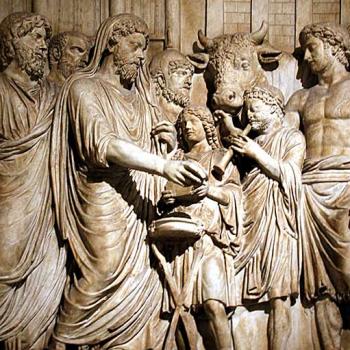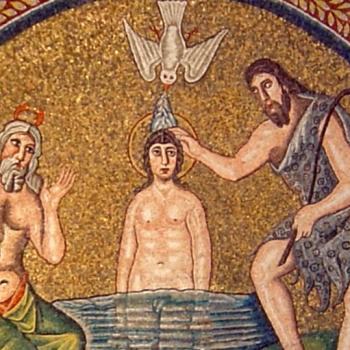
Oft forgotten amid the Holy Week observances of Palm Sunday, Maundy-Thursday, Good Friday and then Easter is Holy Saturday, or Black Saturday, the day Jesus supposedly lay in the tomb after his crucifixion on Friday and prior to his resurrection on Sunday.
But this day worked on the imagination of early Christians in fantastic ways. In the Apostles’ Creed is the statement that Jesus “descended into Hell” as it is often translated into English. But in the Greek it is κατελθόντα εἰς τὰ κατώτατα, or “going down into the lowermost parts,” and in Latin something almost identical, descendit ad inferos, or “he descended to the lower ones/places.” This is not necessarily Hell, because such a concept was not fully worked out yet. It was rather the netherworld or underworld of Greco-Roman mythology, the conception of which would eventually provide us with the imagery most commonly associated with Hell.
The most fascinating account of Jesus going down to the underworld has been handed down in the Gospel of Nicodemus, an apocryphal work that includes the Acts of Pilate (yes, that Pilate, whose ahistorical contrition in the Gospels is later elaborated to the point that he becomes canonized in some Christian sects) and Christ’s Descent into Hell. The older, out-of-copyright translation of Nicodemus by M.R. James is available in many places online. But the more updated and much less baroque translation by J.K. Elliot is far superior.
Probably from about the fifth or sixth century (though its dating is not without dispute), the Gospel of Nicodemus is a fascinating example of Greco-Christian syncretism — that is, of the mythological blending of Christian and Greco-Roman traditions. The modern nature of Hell and the afterlife in general has been the product of such syncretism; Dante’s version of that place, as told in his famous Inferno, has embedded itself in our culture—and much of that work was taken from Book 6 or Vergil’s Aeneid, wherein the hero descends into the underworld (as all good heroes in such stories must), where he witnesses the punishments of the wicked.
In Christ’s Descent into Hell, transmitted to us in a number of manuscripts (which boil down to one Greek version and two Latin ones), Satan has not yet been fully blended with Hades, the Greek god of the underworld. Today the two have been merged to the point that Hades is almost always presented as blackened and evil (see such popular movies as Disney’s Hercules or Percy Jackson and the Lightening Thief), though he was not necessarily so in pre-Christian mythology. Indeed, the figure of Hades isn’t particularly evil in Christ’s Descent. He was simply the keeper of the underworld, who appears at times more powerful than Satan himself.
In Christ’s Descent, Satan and Hades have numerous conversations about Jesus prior to and after his arrival in the netherworld. A personification of the underworld and death itself, Hades, “the insatiable one,” questions Satan as to how they will withstand Jesus when he appears to be able to raise the dead at a single word. Indeed, Hades muses on the fact that Lazarus had recently up and walked out. He then orders Satan to go out to the gates and contend with Jesus “if you can.”
When Jesus does come and free the souls (which include an all-star cast of Biblical figures such as Abraham, Isaiah, David, and even Adam), he has the angels bind Satan and hand him over to Hades to be held until his second coming. The god of the underworld then poetically rebukes the angel of darkness:
O Beelzebub, heir of fire and torment, enemy of the saints, through what necessity did you contrive that the King of Glory should be crucified, so that he should come here and strip us naked? Turn and see that not one dead man is left in me, but all that you gained through the tree of knowledge you have lost through the tree of the cross.
Satan has thus not yet become the overlord of Hell, a role he so often plays in the imagination of Christians today. Rather, the Christians of this period still saw Hades as the god of the underworld, or at least the embodiment of death and the unblessed afterlife. (Nicodemus goes on to show the few folks who are in heaven: Enoch and Elijah, and the “good thief” crucified with Jesus.)
The Gospel of Nicodemus serves as yet another reminder that Christianity arose in the Greco-Roman world, absorbing much of its aesthetic along the way, and passing it to us in a wonderfully blended concoction. It also problematizes present-day visions of the fiery eternal punishment that we are everywhere served up, from the Left Behind series to the disturbing Hell Houses that each Halloween crop up in fundamentalist circles. The truth is that our ideas about Hell are the product of a long process — not a neatly transmitted one — that blended Hebrew, Greek, Roman, and other mythologies. Christians are reinventing them today as much as they did two millennia ago.
 About Don M. Burrows
About Don M. Burrows
Don M. Burrows is a former journalist and current college preparatory school teacher. Don holds a Ph.D. in Classical Studies with a Ph.D. minor in New Testament. A former Christian fundamentalist, Don is now a member of the United Church of Christ and can be found routinely advocating that the Bible cannot be read or explored without appreciating its ancient, historical context. Don lives in Minneapolis with his wife and three young children. Don blogs at Nota Bene and can also be found on Facebook.












